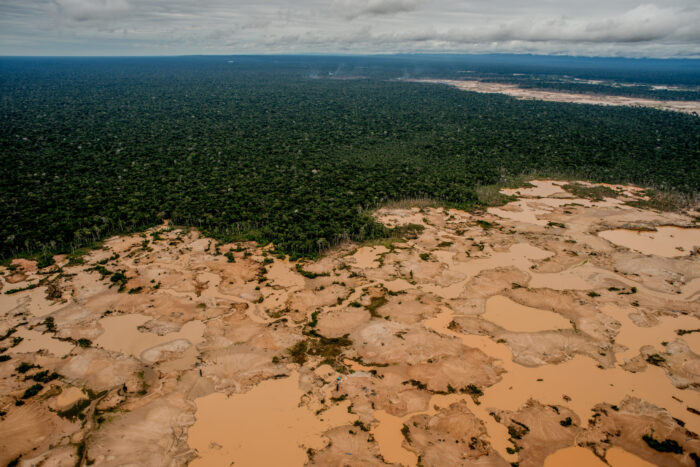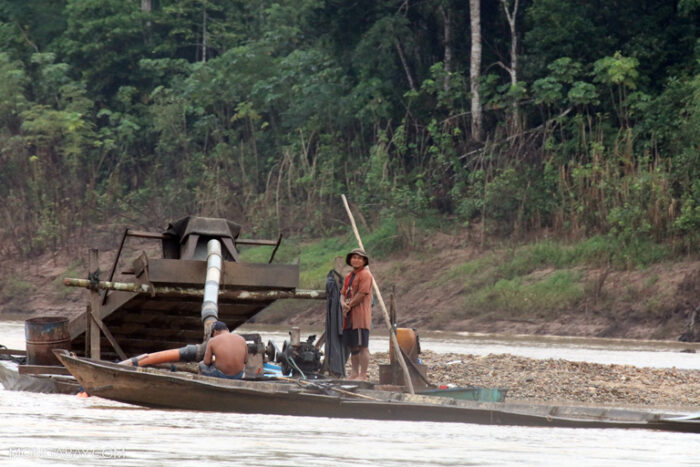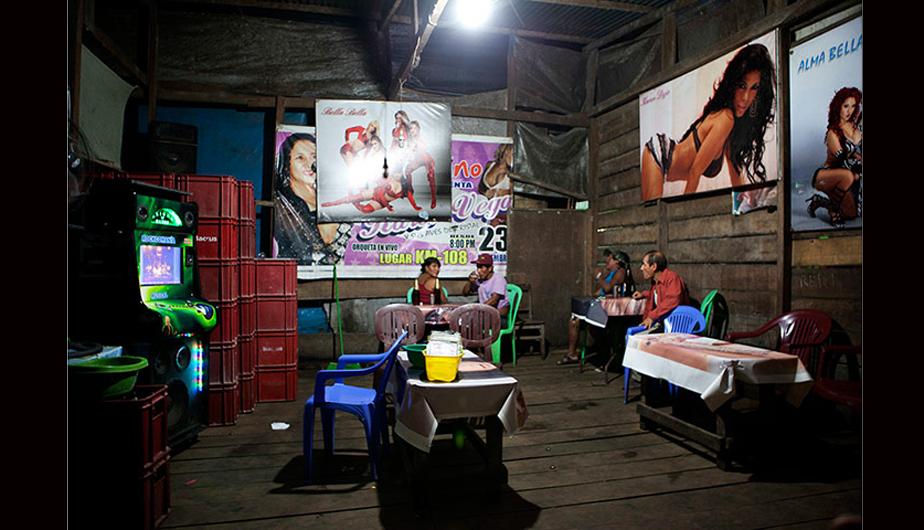This article was published by David Hill on his Substack account on 6 November. You can subscribe to his posts here. LAB is grateful for his permission to reproduce it. The images have been added by LAB.
The main image, above, shows a bar in a mining camp in Madre de Dios, but is not the location mentioned in the article. Photo: Infoamazonia
“Two of the girls had chains around their ankles and it was clear they were drugged.”
Nothing is destroying the Peruvian Amazon – one of the world’s largest expanses of tropical forest – quite like gold-mining. Not oil or gas exploitation, not logging, not oil palm, not cattle-ranching, not coffee, not coca grown for cocaine or cacao for chocolate. By far the most impacted region is Madre de Dios in the south-east of the country, where huge swathes of once lush forest have been transformed into barely-believable deserts and wastelands. According to the US-based NGO Amazon Conservation Association a few months ago, almost 20,000 hectares of forest in the southern Peruvian Amazon were razed for gold-mining in 2021 and 2022 alone.

The impacts of this gold-rush and what it involves have been alleged and/or documented for many years: deforestation, contamination of water sources by mercury, wildlife habitat destruction, biodiversity loss, Indigenous territories and protected areas invaded, a human health crisis, money laundering, child labour, murders, disappearances, human trafficking, prostitution and even, as I highlighted in The Guardian some years ago, the auctioning of young virgin girls on Friday or Saturday nights. Peru is Latin America’s biggest producer of gold, with most of it ending up in countries like Switzerland, Canada, India, the UK and the US.
But what is life like in the mining towns or camps that have been springing up across Madre de Dios, where the miners themselves live or base themselves? Access for journalists, NGO workers, activists, scientific researchers and even Peruvian authorities can be notoriously difficult, if not impossible, dangerous or fatal. Fly a drone over instead and someone might well shoot it down.
Earlier this year I learnt that a colleague and friend of mine – whose name it is safer not to reveal – once stumbled, some years back, into one of Madre de Dios’s many camps. Here, via email, he explains how that happened and what he saw:
DH: Set the scene for us. Can you say exactly – or at least roughly – where you were?
Anonymous source (“AS”): I found myself immersed in the world of environmental issues and human rights conflicts while working for an NGO, and my responsibility was to focus on Latin America, constantly seeking new avenues of research where we could make a significant impact or address urgent matters. During that time, and even now, the Amazon region stood out as an area plagued by recurring problems related to natural resources and human rights. Peru, in particular, had become a hotbed for investigations due to the escalating tensions between Indigenous communities, protected areas and the construction of massive infrastructure projects like roads and hydroelectric plants.
The year 2009 witnessed a pivotal event known as the “Baguazo”, where a clash between the police and protesting Indigenous communities resulted in numerous deaths and 100s of injuries. This incident further highlighted the importance of environmental protection in Peru and the potential positive impact it could have. Within this context, we delved into various cases, one of which involved a proposed road cutting through a national park where communities still lived without any contact with the outside world. Our exploration led us to travel along a highway in Madre de Dios, near [the town of] Puerto Maldonado. This region was severely affected by the detrimental consequences brought about by these mega-projects, particularly illegal mining.
DH: Ok, so you were somewhere in Madre de Dios. Travelling in a small or big group?
AS: Our decision to base ourselves in Puerto Maldonado was primarily driven by the convenient air connections it offered with Lima. On that day, our group consisted of four individuals: a knowledgeable local taxi driver, myself and my two European colleagues. Because my colleagues stood out so obviously, we deemed it necessary to exercise caution and not expose them to unnecessary risks.
DH: At what point did you realise you were near a mining camp? As I remember it from what you said before, you had stopped for some other reason, noticed the camp, and then decided to walk in. Something like that?

AS: We were on our way to interview an Indigenous leader who had received pressure from the government for opposing these mega-projects, when we saw an artisanal dredge panning for gold in an area that had apparently been deforested recently. That’s when I asked the driver to stop because I wanted to take a look at it. He responded that it could be dangerous if the owner was nearby and that he might think we were the police, so that’s why I decided to inspect it with the driver as company.
DH: Sounds like a good idea.
AS: Just as the driver had warned, when we approached the dredge and I took out a small camera to photograph it, an intimidating-looking man appeared with a sawn-off shotgun on his back, asking what we were doing. I responded with a lie: I was interested in entering the gold business and wanted to see how it worked and if it was worth it. He calmed down and explained to us that the vein of gold in the Amazon was spread far and wide and that’s why they had to cut down the trees and dredge the land to separate the gold from the vegetation, and that if you were lucky you would be in the jungle for one month or up to four months at a time, depending on how much gold you wanted to get out. He also said that after two months in “la selva” [“the jungle”] you go “crazy”, and that there was a camp about 100 meters from where we were, which we could visit.
DH: So you visited. Just you and the taxi-driver, or did the guy with the sawn-off shotgun go with you?
AS: He came with us. As we walked, he began to warn us about what we should expect to see. He was referring to the chaotic state of the place: shacks of all kinds, some made of blue tarpaulin, others from old corrugated iron. Inside, most of them had a mattress and a chair. There were also shacks turned into showers, one acting as a basic provisions store – with cans of tuna, alcohol, mercury, coca, bico [bicarbonate of soda] and other basic foods – while the largest was a kind of bar. In total, I think there were about 10. The warning the man gave was due to the tense atmosphere in these camps – being far from any urban centre, the State is non-existent, and this means that any type of order or justice can only be achieved by unconventional means: firearms, machetes or simple physical violence. These miners have often been in the jungle for months and their mental state is almost paranoid due to the use and abuse of substances and their lack of contact with other people. The man accompanied us to the shack that served as a store and left us with the warning to “caminen con cuidado” [“Proceed with caution”].
DH: I’ll say! Just before I ask you what happened next, I’d like to know what your two European colleagues made of you entering the camp. Did they try and stop you?
AS: Well, both colleagues had to stay in the car, which was parked about 200 meters from where we had seen the dredge. Before I got out, they both expressed their concern – one even tried to dissuade me – but after a small talk about the risks we agreed that the driver and I would go, given that we could blend in easily, and on the condition that we would be as quick as possible.
DH: Ok, so what happened next? Anything you remember in particular about the store?
AS: Nothing unusual: rusty corrugated iron walls, a yellow lightbulb, a few boxes of goods, a bag of coca leaves, a sign saying “Cerveza Cusqueña” [“Cusqueña beer”] and another with a list of prices. What I remember most clearly was the stench: totally nauseating. It was everywhere. The deeper I ventured into the camp, the worse it got. It was the shacks serving as toilets and showers, with very basic drainage – or none at all – so urine etc would just run right through the camp along some improvised channel.
DH: Sounds horrendous. Where did you go after the store?
AS: The bar. It was the largest shack, about six by eight metres. The walls were made of blue tarpaulin, the floor was dirt, and from the ceiling hung a row of light bulbs linked by a cable that had given way due to the heat. It was the same smell as the rest of the camp mixed with beer and other alcohol. Near the entrance, dozing on the edge of a bench, lay a young girl – between 15 or 16 years old, wearing a very short dress. When she saw me, she stood up and caught up with me near the door – the way she walked made it clear she was really zoned-out. She asked what I was going to drink and if I wanted “company”, and it became obvious that she had been drinking – the smell she exuded was strong. After asking me those questions, she pointed to the far corner where four girls of similar age were sitting in a semicircle, and when they turned around I could see that two of them had chains around their ankles. They had a lost look on their faces and it was clear they were drugged – they could barely mumble a few words between them. I asked: “Why are they chained up?” and the answer was: “Because they’ve been behaving badly.” I don’t think they were there or in that state out of their own volition: it was so they couldn’t escape and could be manipulated. I indicated I didn’t want anything and that I was leaving. I’d seen enough.
DH: Can you remember what kind of chain exactly?
AS: It was galvanised, not very thick.
DH: And when you say “drugged”, any ideas what with?
AS: I assume it was paco [a coca-based paste, a by-product of making cocaine].
DH: And they were there, effectively, as “prostitutes”, right? To have sex with the miners?
AS: Yes, that explains the question about “company” – it implies drinking with the girls and then using one of the other shacks to have sex.
DH: I assume you knew that gold-mining in Madre de Dios involves human trafficking and child prostitution, but I imagine you were still shocked?
AS: I knew, and it wasn’t the first time I’ve been in a place of squalor – when I was a child I used to live in a poor barrio [urban district]. Yet I’ve never seen a person chained up before, and it never stops shocking me seeing young girls used and abused.
DH: Final question: what would you say to someone who has been buying gold from Peru?
AS: In the case of individuals I’d say that there are fair trade alternatives that don’t involve crimes against children, women or communities, or the use of mercury. It might cost more, but won’t be fuelling abuses and the degradation of other people or the environment. In the case of companies, it’s more complex and governments need to intervene, regulate and sanction. Not everything can be about profit.
DH: Thank you for sharing this with us.
You can support David Hill’s writing by pledging a future subscription. You won’t be charged unless they enable payments.

